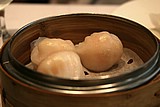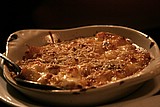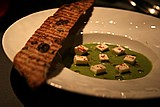Home |
Restaurants by City
|
Food Photography |
Archive | Philosophy |
![]()
Right now we are eating in Seattle, Washington.
|
Tuesday
2005
Permalink
|
Eating in a Small Town, Regina, SK, Canada, tasted on June 26 & 27, 2005 I spent a couple of days in nowheresville this past weekend - Regina, Saskatchewan (that's in Canada for anyone wondering). This is a small city of just under 200,000 people. It's just a little bit smaller than the city of Rochester, New York for comparison purposes. OK. It's not like I was expecting some amazing food in Regina. And mind you, the internet is of no use in this regard as searching it for good restaurants there was kind of useless. But I thought to myself, this is not the big city, this is a small town, and you need to find their specialties. While Regina is small it is in (what seemed to me) like the breadbasket of Canada. It's the prairie with endless miles of fields growing food, and the raising of cattle. And these folks don't just eat cows. They like elk, and buffalo, and all sorts of things that walk around on four legs and are made of red meat. We figured steaks might be good, but in fact, the various steakhouses seemed kind of Sizzlerish. Again, the internet (which I love and adore with all my heart) was really of no use. Finally we ended up eating at two different places: La Bodega, a "tapas" place and the Cortlandt Dining Room at the Hotel Saskatchewan. When I saw a sushi platter on the menu at La Bodega, I knew we were in trouble. Frankly, it was probably the hippest restaurant in Regina, but it also seemed thousands of miles from any body of water with fish I'd like to eat. So sushi was out of the question. We tried sticking to only things that were tapas-ish, except for two problems: the servings were over-sized almost entrees, and none had any flavor. The gazpacho for example was a nice consistency and texture, thick and full of tomato meat, but the only flavor came from the periodic pockets of cumin. As for the Cortlandt Dining Room, normally I stay away from hotel restaurants, but they had local Elk on the menu so we thought we might have a shot at trying something local prepared well. And for a moment I had hope. The salmon bisque came out so hot that it could have instigated a McDonald's style lawsuit. But once it cooled down, the flavor was actually quite nice. Kind of a buttery salmon. Not too strong, but definitely present, and the texture was nice and thick. Soothing. After that things went mostly downhill. The tempura'd veal was flavorful but kind of random. And the elk, well, I admit this was the best prepared elk I'd ever had. Of course it's also the only elk I've ever had. I didn't mind that it was a touch chewy. I did mind that it had no significant flavor. If the texture of the meet isn't going to stand out, the flavor better. I'm sure some Reginan (is that what they're called) will write to me and tell me about the brilliant food I missed at some particular restaurant or market. And they may be right. But here's my sneaking suspicion. Most cities of this size, and almost all smaller cities simply do not have places to get consistently great food. Not at the scale of an entire menu from a restaurant. What they may have is a dish at one place, and a particular menu item at another that are local specialties that rise above the fray. It's understandable that a city at a smaller scale would have its quality food at a smaller scale. The blueberry pie at a local diner, the hot dogs at a particular stand, etc. That said, and I am sure there are exceptions, I don't know if small town food will ever be for me. The impressions of big city food are poor, and the local high quality items are too hard to find. And to be honest, once I were to find them, even if they were spectacular, they wouldn't be enough to keep my interest very long. Metropolitan Seattle has around 2.5 million people. And I find myself bored here. Next time I go to a small town I either find a local I trust to take me to the best Elk Jerky vendor in the province, or I bring a bag lunch.
|
|
Our Sponsors
Free Car Listings Hot Tubs Stools Saunas Bar Stools - Calendar and Event Schedules - Food Events and Calendars - Wine Events and Calendars - Digital Photography Resources - Software for Advertisers - Jewish Gifts and Judaica - Howard Stern Podcast - ponytailed blogger Jonathan Schwartz

Browse tastingmenu
Home |
Restaurants by City X |
Food Photography |
Archive | Philosophy |
![]()
Free eBooks: All About Apples
| Autumn Omakase
More:
Discussion |
Cool Food T-Shirts |
Ingredients
| Markets |
Recipes
Search |
Blog FAQ |
Other
Blogs
Best of tastingmenu
|
City View
Entry: July 6, 2006 |
Blue Plate
Entry: June 19, 2006 |
L'Atelier de Joël Robuchon
Entry: July 18, 2006 |
Browse by City
Boston | Chicago | Houston | Las Vegas | Los Angeles | Maui | New York | Philadelphia | Portland | San Francisco | Seattle | Toronto | Utah | Vancouver | Washington D.C.
Bangkok | Beijing | Hong Kong | Seoul | Tokyo
Amsterdam | Berlin | Italy | London | Madrid | Paris | Vienna
Browse by Month
2006
2005
2004
2003
2002
2001
Comments, questions, or feedback:
info / at / tastingmenu / dot / com
All pages Copyright (c) 2001-2006 tastingmenu.com
Last modified 01/30/07.



